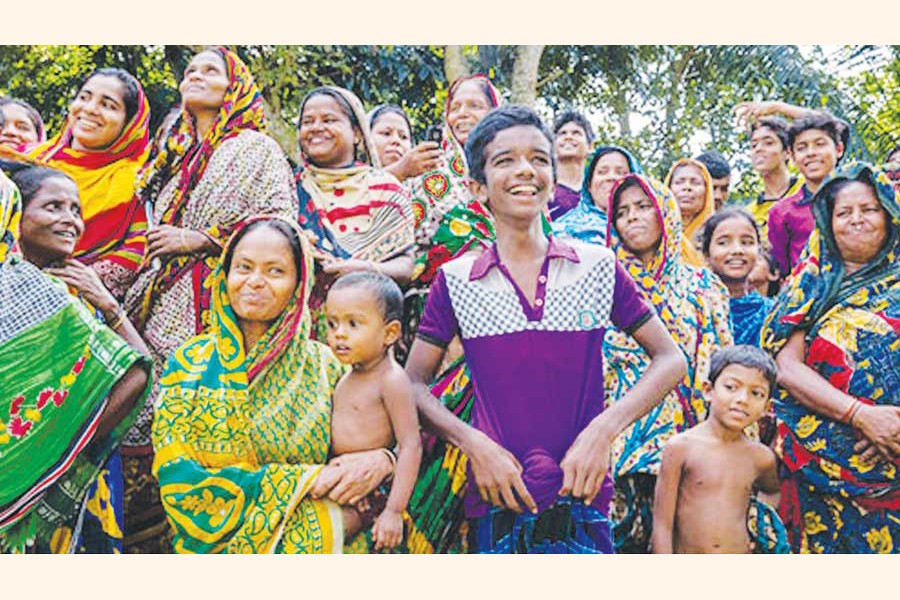
Local economic development: When the people take charge
Babui Salsabil | Sunday, 24 November 2019

 Development practitioners often tend to detach the people that they try to benefit from the process of development, albeit unconsciously. That is, they think of the beneficiaries - for the lack of a better word - as passive recipients of whatever value they try to create for them, instead of thinking of them as people with active agency who have the power and capacity to change their present conditions themselves. Whereas, all they may be lacking is a small push. Being a practitioner in the development sector of Bangladesh for over five years, the author has had the opportunity to work on many different development initiatives, but the one that has struck the biggest chord with her was: Local Economic Development (LED). Initiated by a renowned international development organization, this project attempted to improve the local economies by untapping the local potentials that were already present, however, due to unyielding constraints the local people could not unleash their true potential.
Development practitioners often tend to detach the people that they try to benefit from the process of development, albeit unconsciously. That is, they think of the beneficiaries - for the lack of a better word - as passive recipients of whatever value they try to create for them, instead of thinking of them as people with active agency who have the power and capacity to change their present conditions themselves. Whereas, all they may be lacking is a small push. Being a practitioner in the development sector of Bangladesh for over five years, the author has had the opportunity to work on many different development initiatives, but the one that has struck the biggest chord with her was: Local Economic Development (LED). Initiated by a renowned international development organization, this project attempted to improve the local economies by untapping the local potentials that were already present, however, due to unyielding constraints the local people could not unleash their true potential.
While many development initiatives may already engage in local participation in one way or the other, at the heart of the Local Economic Development (LED) project was participatory decision-making. The project operated on the notion that every poor or underprivileged economy has the potential, and often even the necessary resources required to drive them towards more prosperity. However, there could be some bottlenecks that prevent the people from reaching their desired goals. The LED project would help people in just that regard - that is help them get rid of the bottlenecks - so that they could move towards prosperity on their own. And it would involve the local people at every step of the work.
Two municipalities from Bangladesh were selected where local economic development would be implemented on a test basis. The local people were started being involved from the planning stage, where they first gave feedback on what problems their specific trades or jobs were facing. These meetings included local businesses, women entrepreneurs, representatives from the local government, bank officials, local press clubs and so on. While on one hand, the different categories of actors gave perspectives on various aspects of the local economy, it also helped triangulate the problems. That is, talking to one set of stakeholders either reaffirmed or refuted what the other stakeholders deemed as the main problems and that way, the project could narrow down to a list of problems that affected most of the local people. Then the team talked to these different groups about what they thought could be the potential solutions to the problems that they had deemed the most important. What was surprising was the level of in-depth thought that each of them put in and the kind of solutions they came up with. The most inspiring of these sessions were the ones that involved the women entrepreneurs who gave a refreshingly new perspective on how innovative the women working at such underprivileged areas were. In the instances, where the local actors said they had constraints that were beyond their means to solve, the project staff stepped in with suggestions for help such as proposing to create possible linkages with potential buyers for their products, connecting with trainers for training them on their trade and so on.
Next, the implementation team talked to all the groups of actors together in one common, big platform, regarding what they thought, as a group, were the leading problems in their locality and then, by a system of voting, the most pressing ten problems were selected, after which the possible solutions were proposed. Lastly, for each one of the proposed solutions, one representative was selected from the local participants, who would each take lead to implement each of these interventions, with assistance from project staff throughout the process.
In the span of the next few months, these interventions were rolled out. This process, of course, was not smooth. Each step faced many obstacles that the local actors tried to mitigate in collaboration with the project staff. Some ideas had to be abandoned due to the difficulty involved in their implementation, while new solutions were taken up as new ideas were generated in the course of the project.
However, what stood out in the whole process was the level of energy and momentum that was seen in the participating groups' dynamics. Compared to any other mode of implementation, in this one where participatory approach was used, a distinct level of enthusiasm was exhibited by the local people. And even the acceptance of the ideas presented by the project team was much higher compared to other trickle-down processes. This could have been owing to the fact that since the project was equally receptive to the ideas generated by the local people, the locals were also more welcoming of the ideas that the project proposed.
Sure, it took much longer time to reach decisions regarding which interventions to select or which constraint areas to address since a lot of diverse inputs were taken into consideration. There would be occasional disapproval from the donors or frustration among the project team regarding the slow pace at which the project was moving. But at the end of the day, there was no ambiguity on either end that the method being followed was generating the exact outcome that was desired - the best possible solutions to the most pressing problems as identified by the collective input and whole-hearted participation of the locals.
LED was eye-opening towards the beauty, and efficiency, of the participatory approach in executing development projects. The local people knew exactly where their constraints lied; they also knew where their strengths were as well as where their weaknesses were. What they lacked was a platform where they could present these problems; a platform who could take their voices up to a higher authority, or which would connect them to a market that they lacked access to.
This method was not a hundred percent flawless. For example, there were still tensions between rival groups of business associations who hesitated to participate in discussions in one common platform, or complicacies in the local bureaucracy that put an end to some initiatives midway. However, it brought out a tremendous potential. The take-away from this initiative was that letting the people take charge of their own development gives them a sense of power and autonomy that helps unlike passive recipients. And when people are empowered, they take lead in some extraordinary ways, accept ownership and come up with creative and ingenious solutions that only local minds familiar with the local context can. And the power of people when they work together creates an exceptional level of synergy.
Lastly, a project designed entirely based on the participatory approach of the local people maybe one of the first of its kind in Bangladesh, and hence, prone to many mistakes, but it shows great promise. And hopefully, with more implementations of such initiatives and more trial and errors, this approach will attain perfection.
...........................................................................................
Babui Salsabil is a development practitioner with experience in various donor-funded projects within Bangladesh and in South Asia. Her area of expertise has been in the Private Sector in Development arena, designing, implementing and evaluating projects to promote economic and social development. Currently, Babui is pursuing her Master's in Global Human Development (GHD) at Georgetown University, USA. Her email is: bs1091@georgetown.edu